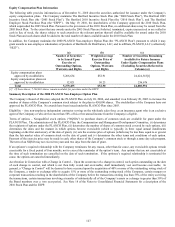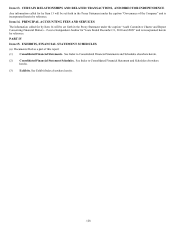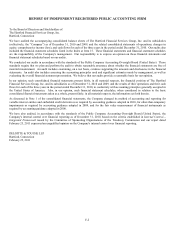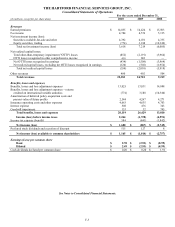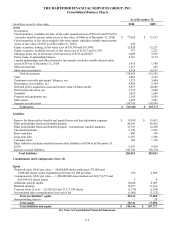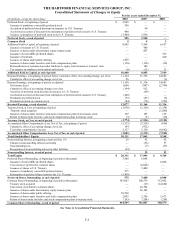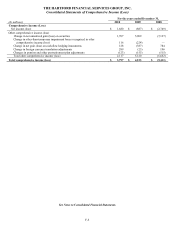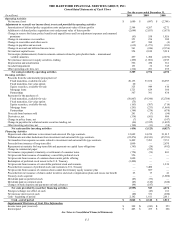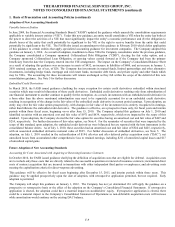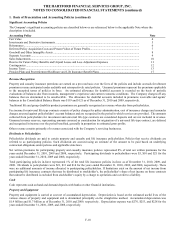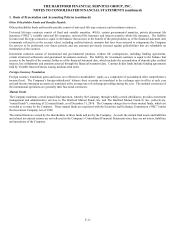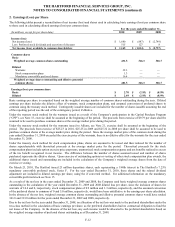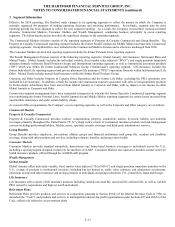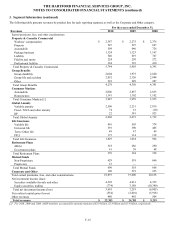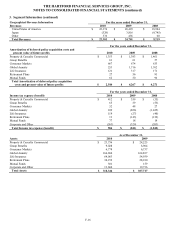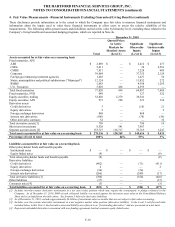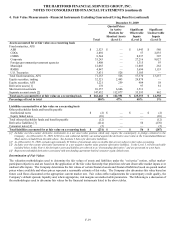The Hartford 2010 Annual Report Download - page 137
Download and view the complete annual report
Please find page 137 of the 2010 The Hartford annual report below. You can navigate through the pages in the report by either clicking on the pages listed below, or by using the keyword search tool below to find specific information within the annual report.THE HARTFORD FINANCIAL SERVICES GROUP, INC.
NOTES TO CONSOLIDATED FINANCIAL STATEMENTS (continued)
F-9
1. Basis of Presentation and Accounting Policies (continued)
Adoption of New Accounting Standards
Variable Interest Entities
In June 2009, the Financial Accounting Standards Board (“FASB”) updated the guidance which amends the consolidation requirements
applicable to variable interest entities (“VIE”). Under this new guidance, an entity would consolidate a VIE when the entity has both (a)
the power to direct the activities of a VIE that most significantly impact the entity’ s economic performance and (b) the obligation to
absorb losses of the entity that could potentially be significant to the VIE or the right to receive benefits from the entity that could
potentially be significant to the VIE. The FASB also issued an amendment to this guidance in February 2010 which defers application
of this guidance to certain entities that apply specialized accounting guidance for investment companies. The Company adopted this
guidance on January 1, 2010. As a result of adoption, in addition to those VIEs the Company consolidates under the previous guidance,
the Company consolidated a Company sponsored Collateralized Debt Obligation (“CDO”), electing the fair value option, and a
Company sponsored Collateralized Loan Obligation, at carrying values carried forward as if the Company had been the primary
beneficiary from the date the Company entered into the VIE arrangement. The impact on the Company’ s Consolidated Balance Sheet
as a result of adopting this guidance was an increase in assets of $432, an increase in liabilities of $406, and an increase in January 1,
2010 retained earnings, net of tax, of $26. The Company has investments in mutual funds, limited partnerships and other alternative
investments, including hedge funds, mortgage and real estate funds, mezzanine debt funds, and private equity and other funds which
may be VIEs. The accounting for these investments will remain unchanged as they fall within the scope of the deferral of this new
consolidation guidance. See Note 5 for further discussion.
Embedded Credit Derivatives
In March 2010, the FASB issued guidance clarifying the scope exception for certain credit derivatives embedded within structured
securities which may result in bifurcation of these credit derivatives. Embedded credit derivatives resulting only from subordination of
one financial instrument to another continue to qualify for the exemption. As a result, investments with an embedded credit derivative in
a form other than the above mentioned subordination may need to be separately accounted for as an embedded credit derivative
resulting in recognition of the change in the fair value of the embedded credit derivative in current period earnings. Upon adoption, an
entity may elect the fair value option prospectively, with changes in fair value of the investment in its entirety recognized in earnings,
rather than bifurcate the embedded credit derivative. The guidance is effective, on a prospective basis only, for fiscal years and interim
periods within those fiscal years, beginning on or after June 15, 2010. The Company adopted this guidance on July 1, 2010 and
identified securities with an amortized cost and fair value of $971 and $639, respectively, which were impacted by the scope of this
standard. Upon adoption, the Company elected the fair value option for securities having an amortized cost and fair value of $447 and
$214, respectively. For further discussion of fair value option, see Note 4. For the remainder of securities that were impacted by the
scope of this standard, upon adoption, the embedded credit derivatives were bifurcated but are reported with the host instrument in the
consolidated balance sheets. As of July 1, 2010, these securities had an amortized cost and fair value of $524 and $425, respectively,
with an associated embedded derivative notional value of $525. For further discussion of embedded derivatives, see Note 5. The
adoption, on July 1, 2010 resulted in the reclassification of $194, after-tax and after deferred policy acquisition costs (“DAC”), net
unrealized losses from accumulated other comprehensive loss to retained earnings, including $211 of unrealized capital losses and $17
of unrealized capital gains.
Future Adoption of New Accounting Standards
Accounting for Costs Associated with Acquiring or Renewing Insurance Contracts
In October 2010, the FASB issued guidance clarifying the definition of acquisition costs that are eligible for deferral. Acquisition costs
are to include only those costs that are directly related to the successful acquisition or renewal of insurance contracts; incremental direct
costs of contract acquisition that are incurred in transactions with either independent third parties or employees; and advertising costs
meeting the capitalization criteria for direct-response advertising.
This guidance will be effective for fiscal years beginning after December 15, 2011, and interim periods within those years. This
guidance may be applied prospectively upon the date of adoption, with retrospective application permitted, but not required. Early
adoption is permitted.
The Company will adopt this guidance on January 1, 2012. The Company has not yet determined if it will apply the guidance on a
prospective or retrospective basis or the effect of the adoption on the Company’ s Consolidated Financial Statements. If retrospective
application is elected, the adoption could have a material impact on stockholders’ equity. If prospective application is elected, there
could be a material impact to the Company’ s Consolidated Statement of Operations as non-deferrable acquisition costs will increase
while amortization would continue on the existing DAC balance.


